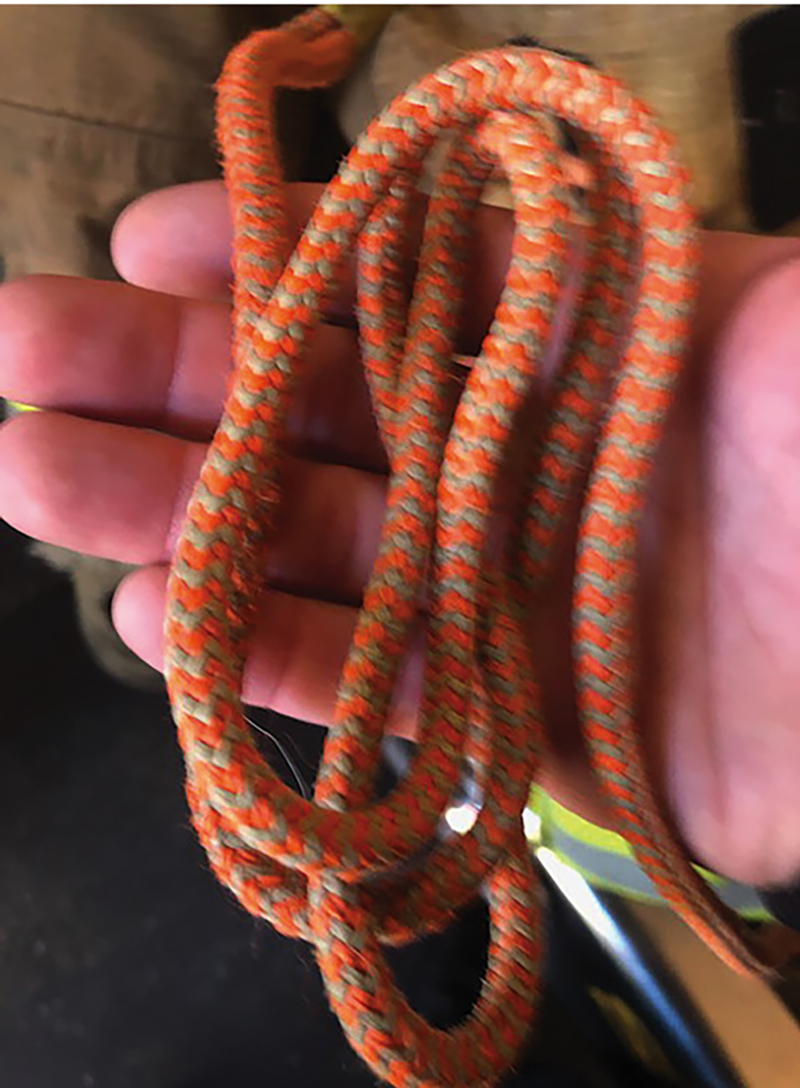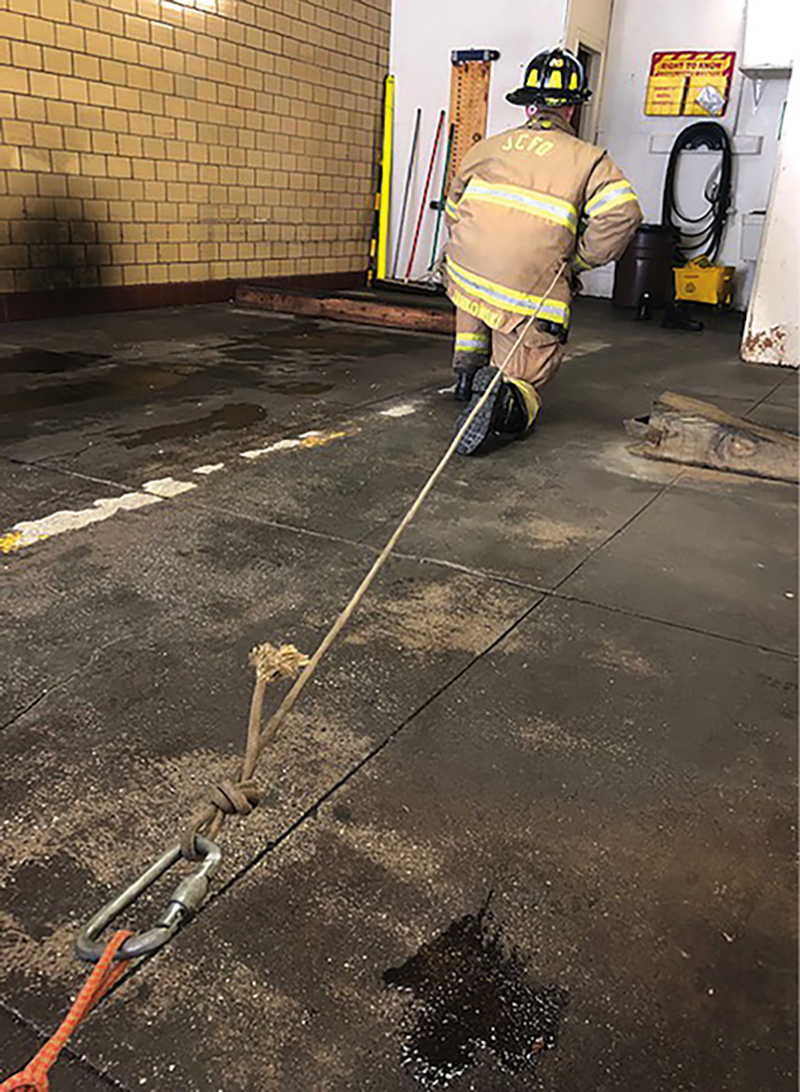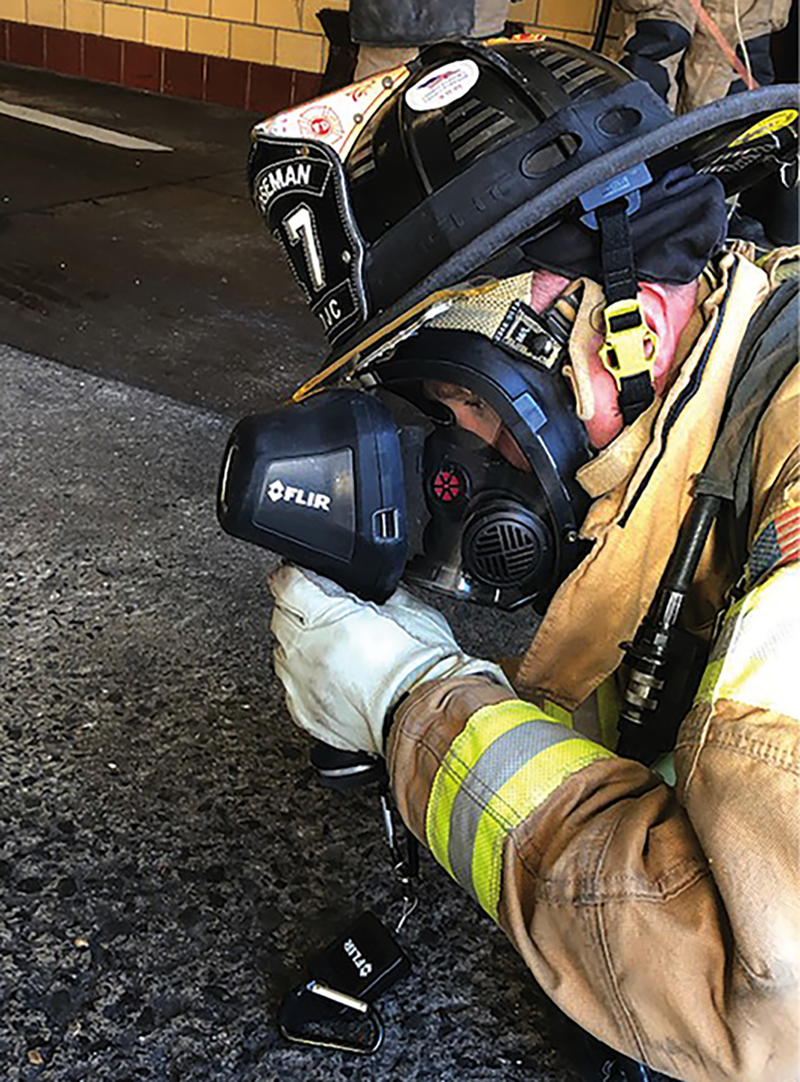Depending on your response district and standard operating procedures, vent-enter-search (VES) is an operation that firefighters perform with relative frequency. It involves venting a window from a ground ladder (generally a bedroom or rear room); briefly waiting for a condition lift, if needed; entering; conducting a quick search for life; and exiting back down the ladder. It is important to note that “waiting” means mere seconds for the thickest smoke to exit the uppermost reaches; then, you can get in underneath it and use any potential fresh air layer to aid in your search. This is generally when the fire is either adjacent to the room to be searched or, more likely, the floor below and it is not yet controlled.
RELATED FIREFIGHTER TRAINING
- Putting ‘Fire Location’ Back into the Search Function: Accounting for Truck Company Operations
- Aggressive and Practical Search: It’s Still About the Victim
- Rescuers vs. Rescued: Are Our Priorities Backward?
In recent years, “isolate” has been inserted into the VES acronym as a reminder for firefighters to isolate the door to the room that, once entered, they are searching. We are taught that this is to prevent conditions from rapidly enveloping the area and hindering or outright quelling the survivability profile.
VES Requirements
VES is a very specific task, often given to a sole firefighter. It requires discipline, good window profiling, proficiency in reading the atmosphere, and the ability to quickly dip in and out of a very hostile environment—all done without the protection of water (save for an extinguisher) or firsthand knowledge of the progressing attack below. Another requirement is the ability to singularly move a potential victim to refuge or rescue. Nevertheless, with a purported or confirmed hazard such as a second-floor rear bedroom of a 2½-story frame unattached private dwelling, it is common to see an average-staffed department send a single ladder firefighter to the rear to take the windows and get into that room to search. This is done often to provide two potential avenues to the victim.
Likewise, it is common to see firefighters ascending the fire escape to gain C-side access to a fire apartment’s rear bedrooms while the fire blows out the windows on the A side. This also qualifies as VES, even though the “V” in this case must be careful not to draw fire across the apartment.
I will address a technique with which we are all familiar and that enhances orientation; safety; speed; and, sometimes, rescue as it applies to VES. A tagline, timely placed and deployed, can be an invaluable tool to a “blinded” VES operation—by that, I mean one where the atmosphere offers almost no visibility, even after such smoke and heat current has lifted out of the window.
We are well taught that today’s fires carry an increase of smoke thickness, density, volume, and deadliness. Older private dwellings and occupied multiple dwellings have not gotten any bigger. A bedroom in an apartment building built in 1940 is the same size it was in 1940. A third-floor bedroom in an old balloon-frame private home is the same it has always been. Although their volume of atmosphere is the same, their contents, however, now produce smoke that fills it and kills more quickly.
On the other side of newer construction, we must consider open floor plans, extra-large bedrooms, Jack-and-Jill-type second floors, and cluttered conditions that the searching firefighter can face as he crosses that threshold. In both cases, if a search has been blinded, a tagline is a good idea—even from a ground ladder or fire escape.
Deployment
It is important, especially if a lone firefighter is to conduct the search, to ensure that the tagline is affixed outside the immediately dangerous to life or health environment. It is even more important that it is done quickly. VES is often undertaken while under duress and when time is crucial. For this reason, I recommend a tagline that has a large, nonscrew link-style carabiner affixed to the end of your personal tagline (photo 1). I would further call for a tagline that is round as opposed to flat (for dexterity) and no thinner than 6 or 7 millimeters (photo 2). A flat or very thin rounded tagline can likely be lost in a gloved hand. Add zero visibility to all this, and it will not be found. From a ground ladder placed for VES, the firefighter can quickly clip or wrap and clip the tagline around the top rung of the ladder before he enters the window of the bedroom to be searched. (Note: It is crucial is that the other end of the tagline is not permanently attached to you. Have it in a pouch, your pocket, pants, and so on. In the unlikely event that someone mistakenly moves the ladder, should the tagline be clipped or tied to you, you could be pulled backward and injured.) The firefighter can then aggressively proceed to the isolation point, shut the door, and commence the search.

(1) Photos by author.

(2)
The method of deploying the rope is a matter of preference. I elect to keep it clipped to the right side of my personal protective equipment and pay it out of my right pocket with my dominant hand (photo 3); this also keeps it opposite my low-pressure self-contained breathing apparatus (SCBA) air hose. Some firefighters choose to pay out their tagline from a waist pouch or pants pocket. In these instances, be careful not to entwine it with your SCBA valve or hose. It is easier than you might think—one or two full turns in disorienting smoke and you could mistakenly wrap your tagline around your air cylinder valve, thus creating a real problem.

(3)
What is sometimes lost in a tagline search, especially one deployed in a manner not normally undertaken, is the philosophy behind the search for life. Ask any firefighter how he should search the fire floor and he will instantly reply, “From the fire, back.” He’ll likely follow that the floor above a fire has its search start “at the entrance to the floor,” but what about when we enter the floor from a different location than an interior stair or door? I have seen searches aided by ropes (not team search) and start as soon as the rope starts coming out of the pocket, thus mimicking a search starting at floor entrance. It is important to remember that, just like searching these locations without the tagline, prioritize your search of the blinded area from where the victim likely dropped, over to the highest hazard, and then to lowest. It is inefficient to make a tagline search of a bedroom by simply “walking” around. Consider what you looked at before you ascended. Was the window open? There is always the chance the victim made it to salvation through the window and then dropped. Always check!
As you proceed to isolate, at least look at the other side of the door. The victim may have fled to the common hall on waking to a smoke-filled room. Although there are strict parameters on VES, they can be made pliable with the safety of a tagline. Look in the common hall before you close the door. Yes, if it is nighttime, sweep the bed immediately. Closets are important, too, and attached bathrooms need attention. In no way am I saying that neglect of these areas is justified; I am merely placing importance on progressing to likely areas of victim travel first and foremost. In a VES, check the two (or more) exit paths immediately—the area around the window and the door exiting the area.
From a fire escape, you can “tag in” to the apartment in a similar fashion. In these instances, avoid clipping to the stairs of the fire escape or the banister opposite the window you plan on entering (photos 4, 5); these can create trip hazards for other firefighters. You also run the risk of someone simply unclipping it. In other words, clip the tagline, if possible, to the grating of the fire escape landing as close to the window as possible. If broken glass on the fire escape landing is an issue, quickly kick it aside. If windows exist next to each other, wrap your tagline around the space between them and go. Again, you won’t have to be tagging in if you can see in the least, are properly partnered, or are not otherwise hindered.

(4)

(5)
Your thoughts about the progression of your tagline search as you ascend should proceed from the information you have received, your visual on arrival, the condition currently at the window opening, and the escape itself. For example, if you are first arriving to the rear of the structure and the drop ladder is not yet down, it is safe to assume that nobody from the fire apartment came down the escape. Victims will not flee and then dutifully reraise the ladder. The chance of occupancy has then risen.
If it is the middle of the summer and you further observe that an air-conditioning (AC) unit has been pushed out of the fire apartment window onto the escape, it is a good search guess that someone is actively trying to get out of there. Chance of occupancy goes up another tick. (Yes, the AC could be broken, but that’s a confirmation for later in the operation.)
If you observe any fortification measures, assume it is an attempt to secure a sleeping area. The point here is not to profile your entire search but to gain a few fast points of what you are tagging in to search. You need to gather as many on-scene points as possible before you get in there to isolate the atmosphere and search the area.
Extending the Tag
There are reasons that taglines are limited in length, other than bulkiness. It is not common to find a tagline in excess of 50 feet, and with good reason; it is so the searcher is not straying too far from his entry/egress point. The sizes of the areas searched in private homes and apartments are mostly amenable to these modest lines. Speed, orientation, and a quick retrieval are their main purpose.
However, on occasion, there could be an instance where you encounter a larger and unanticipated area once you enter the window to search for life. A duplex, an extension, a removed nonload-bearing wall—almost anything—can make your blind-guided search come up short. In these instances, most times you can rely on standard search practices to orient yourself such as staying in contact with the incident commander, being aware of the exit point or any change in conditions, using your thermal imaging camera (TIC), and so on.
You can also have your search partner, if available, piggyback your tagline with his own. To do this, simply tie a knot near the termination of your tagline and have your partner clip into that knot (photo 6). This way, there is a contiguous contact point between your entry and the search. Again, serious conditions (such as the fire not being under control, good information of a life hazard, and no visibility—the extremity of condition) requires an equal measure of calculated action. We can manage the risk in this fashion. Being vigilant with air consumption and the distance from the exit helps you complete this search, as needed.

(6)
Another option is to have the member extend the tag search clip to the first firefighter and go. This way, there is a firefighter closer to the exit point, monitoring the heat buildup in the path between the two members and at the window, and he can then summon the second firefighter back, if needed. If the firefighter extending the tag encounters the victim, the first firefighter needs to quickly affix that tagline to his own and proceed to the victim’s location (photos 7, 8). Again, teaming up taglines like this pushes the limits of a VES that is inherently limited in scope. If conditions are such that you cannot even see the TIC screen in front of your face, be very measured in how far in you follow your two taglines.

(7)

(8)
Regarding your TIC in a tagline search, it is an excellent idea to place the TIC as close as possible to your SCBA face piece while still on the outside of the window and attempt to look in to get a baseline view of the room and current at ceiling level. In recent years, I have noticed that, with the great advances in TICs, the rubber “hoods” that used to be over the screen on older models have gotten smaller and smaller. These hoods were great for fitting the TIC almost over your face mask, keeping smoke out of the space between the two. As long as you were stationary, this was a great technique prior to entering a room in which you would have no visual. However, it required that you be disciplined enough not to walk or crawl with the TIC completely over your face. In any event, when trying to extend a tagline VES, use a TIC at both the interchange between the lines and the termination point. If you are paused and not moving, hold the TIC at almost floor level, get your face near the screen, and slowly rise up to a crouching position to try to achieve the best visual (photos 9, 10). This will give you the best chance at seeing the screen in a room with thick smoke. Should you have only one TIC between the two search members, the second member can take the TIC to the termination of the tagline point in an attempt to find the victim. Depending on where he is (i.e., the apex of a stair above the fire, near a turn where fire is down the hall), the first member may want to keep it and monitor the atmosphere to call his partner back.

(9)

(10)
It is essential to keep that tagline tidy. Be it VES or not, these lines are deployed for a measure of speed and orientation. A knotty, severed, water-warped line will not serve its purpose. Pursuant to that end, have a “ballpark” idea of the length of your line—have mental points of reference, not just knowledge of how many feet your rope is.
When training or at nuisance calls, take a moment to pay out your tag and see “how far it gets you” into an apartment or floor from the entry point. Create this profile for different types of occupancies and it will eventually be second nature when you are called on to do it under duress. You’ll know that your pocket line “gets me halfway in here” or “out of the bedroom and around the corner” there. The moments you take to create this profile will be paid back to you with a speedy search.
ALEXANDER DEGNAN is an 18-year member of the Jersey City (NJ) Fire Department (JCFD), where he is the captain of #618 Squad Co. 4, a position he has held since 2015. Prior to his captain’s position, he was a 10-year firefighter with the JCFD’s #1013 Squad Co. 4.

